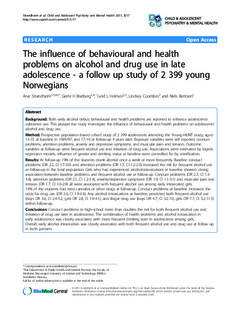| dc.description.abstract | Background: Both early alcohol debut, behavioural and health problems are reported to enhance adolescence
substance use. This prospective study investigate the influence of behavioural and health problems on adolescents’
alcohol and drug use.
Method: Prospective population based cohort study of 2 399 adolescents attending the Young-HUNT study, aged
13-15 at baseline in 1995/97, and 17-19 at follow-up 4 years later. Exposure variables were self reported conduct
problems, attention problems, anxiety and depressive symptoms, and muscular pain and tension. Outcome
variables at follow-up were frequent alcohol use and initiation of drug use. Associations were estimated by logistic
regression models, influence of gender and drinking status at baseline were controlled for by stratification.
Results: At follow-up 19% of the students drank alcohol once a week or more frequently. Baseline conduct
problems (OR 2.2, CI 1.7-3.0) and attention problems (OR 1.5, CI 1.2-2.0) increased the risk for frequent alcohol use
at follow-up in the total population. Girls who had experienced alcohol-intoxications at baseline showed strong
association between baseline problems and frequent alcohol use at follow-up. Conduct problems (OR 2.5, CI 1.3-
4.8), attention problems (OR 2.1, CI 1.2-3.4), anxiety/depressive symptoms (OR 1.9, CI 1.1-3.1) and muscular pain and
tension (OR 1.7, CI 1.0-2.9) all were associated with frequent alcohol use among early intoxicated girls.
14% of the students had tried cannabis or other drugs at follow-up. Conduct problems at baseline increased the
odds for drug use (OR 2.6, CI 1.9-3.6). Any alcohol intoxications at baseline, predicted both frequent alcohol use
(boys OR 3.6, CI 2.4-5.2; girls OR 2.8, CI 1.9-4.1), and illegal drug use (boys OR 4.7; CI 3.2-7.0, girls OR 7.7, CI 5.2-11.5)
within follow-up.
Conclusions: Conduct problems in high-school more than doubles the risk for both frequent alcohol use and
initiation of drug use later in adolescence. The combination of health problems and alcohol intoxication in
early adolescence was closely associated with more frequent drinking later in adolescence among girls.
Overall, early alcohol intoxication was closely associated with both frequent alcohol use and drug use at follow up
in both genders. | nb_NO |
